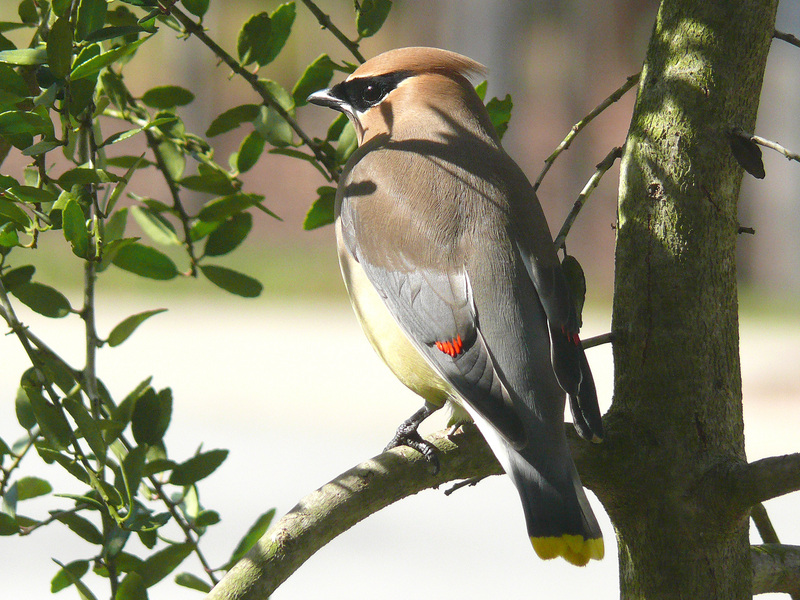Cedar Waxwing (Bombycilla cedrorum) - Wiki Cedar Waxwing
From Wikipedia, the free encyclopedia
Order: Passeriformes
Family: Bombycillidae
[Photo] Cedar Waxwing (Bombycilla cedrorum) perched in the branches of a Weeping Holly tree. Photo taken with a Panasonic Lumix DMC-FZ50 in Johnston County, North Carolina, USA. Date: 26 FEB 2007. Source: www.kenthomas.us/ Author: Ken Thomas (http://commons.wikimedia.org/wiki/User:Ken_Thomas). Release it into the public domain.
The Cedar Waxwing (Bombycilla cedrorum) is a member of the family Bombycillidae or waxwing family of passerine birds. It breeds in open wooded areas in North America, principally southern Canada and the northern United States.
Description
It is 16.5 cm in length and weighs 32 g. It is smaller and browner than its close relative, the Bohemian Waxwing, which breeds further north and west. The tail is tipped with yellow or orange depending on diet. Birds that have fed on berries of introduced Eurasian honeysuckles while growing tail feathers will have darker orange-tipped tail-feathers. Adults have a pale yellow belly. Immature birds are streaked on the throat and flanks, and often do not have the black mask of the adults.
The flight of waxwings is strong and direct, and the movement of the flock in flight resembles that of a flock of small pale European Starlings.
Vocalizations
The calls of these birds include very high-pitched whistles and buzzy trills often represented as see or sree.
Seasonal movements
Outside the breedings season, Cedar Waxwings often feed in large flocks numbering hundreds of birds. This species is irruptive, with erratic winter movements, though most of the population migrates further south into the United States and beyond, sometimes reaching as far as northern South America. They will move in huge numbers if berry supplies are low. Rare vagrants have reached western Europe, and there are two recorded occurrences of Cedar Waxwing sightings in Great Britain. Individual Bohemian Waxwings will occasionally join large winter flocks of Cedar Waxwings.
Birds in winter can be very confiding and will come into gardens for berry bushes and trees and to splash and drink from fountains or bird baths.
Diet
The Cedar Waxwing eats berries and sugary fruit year-round, with insects becoming an important part of the diet in the breeding season. Its fondness for the small cones of the Eastern Redcedar (a kind of juniper) gave this bird its common name.
When the end of a twig holds a supply of berries that only one bird at a time can reach, members of a flock may line up along the twig and pass berries beak to beak down the line so that each bird gets a chance to eat.
Habitat
Preferred habitat consists of trees at the edge of wooded areas, or "open" forests, especially those that provide access to berry sources as well as water. Waxwings are attracted to the sound of running water, and love to bathe and drink from shallow creeks. In urban or suburban environments, waxwings often favor parkland with well-spaced trees, golf courses, cemeteries, or other landscaping with well-spaced trees, bushes that provide berries, and a water source, including fountains or birdbaths, is always a big plus.
Nesting
The nest is a loose open cup built with grass and twigs, lined with softer materials and supported by a tree branch averaging 2 to 6 meters above ground but, at times, considerably higher. The outer diameter of the nest is approximately 12cm to 16cm.
During courtship, the pair may pass a flower petal or insect back and forth repeatedly. Usually 5 or 6 eggs are laid and the female incubates them for 12 to 16 days. The eggs are oval shaped with a smooth surface and very little, if any, gloss. The egg shells are of various shades of light or bluish grey with irregular, dark brown spots or greyish-brown splotches. Both parents build the nest and feed the young. Typically, there are two broods during the mating season. Young leave the nest about 14 to 18 days after hatching.
Cedar Waxwings are also known as the Southern Waxwing, Canada Robin, Cedar Bird, Cherry Bird, or Recellet.
Cedar Waxwings in literature and law
According to experts on the writing of Vladimir Nabokov, this species almost certainly inspired the waxwing mentioned prominently in his novel Pale Fire.
Waxwings are protected by law in the US and may not be kept in captivity.
http://en.wikipedia.org/wiki/Cedar_Waxwing
| The text in this page is based on the copyrighted Wikipedia article shown in above URL. It is used under the GNU Free Documentation License. You may redistribute it, verbatim or modified, providing that you comply with the terms of the GFDL. |
